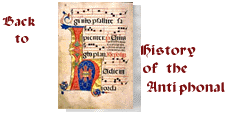
 |
|
 The treatment processHodie et in aeternum
Treatment was carried out to ensure the Antiphonal's
survival today and in the future.
Initially the book had to be "taken down"
or dismantled. Dirt, including dust, insects and flaking black
pigment, were carefully cleaned away from the folds in the leaves.
Due to the rigidity of the stitched vellum repairs
along the backfolds, many of the folios could not open out fully.
Apart from a few that were left as an historic record, these repairs
were removed, revealing thick layers of animal glue. Cleaning
this adhesive away left the vellum noticeably more flexible. Other
rigid and unsuitable repairs were removed also.
A fascinating aspect of treating a 13th century book
in the late 20th century is the mix of technologies that are used.
The consolidation of the flaking text provided one of the most
striking contrasts between the very very old and the ultra modern
in one treatment operation.
After extensive testing of a range of consolidants
- from modern synthetic adhesives to more traditional materials
- we found that the best consolidant was the size or adhesive
made by boiling up parchment scraps in water. This produced a
thin easily applied solution with enough tack to hold the flaking
ink, enough flexibility to move with the pages as they were turned
and it caused very little or no darkening of the inks to which
it was applied.
Once the very labour-intensive consolidation was
complete, work commenced on the repair of the vellum leaves. The
first step was to examine every leaf in the Antiphonal and identify
the areas to be treated and the type of treatment required. Wherever
possible proteinaceous materials such as vellum, parchment, collagen
sausage skin and/or fish skin were used as the repair materials.
Vellum and parchment were ideal for filling areas missing from
the original document while thin films such as sausage skin and
fish skin were used to support other repairs and to hold small
tears and cut together.
The outer folios of most sections were very badly
damaged along the backfolds. To provide the flexibility and strength
required, and to avoid extra bulk, Japanese paper was used with
sausage skin or fish skin to repair these outer folios.
Humidification and flattening were considered for
many of the leaves, in order to remove cockling and distortion.
As the treatment progressed this step was largely abandoned. Vellum
is said to have a "memory", i.e. it has a tendency to
return to any shape it has held for a long time. Humidification
and flattening was working against this very strong "memory"
and in some cases created new distortions that would have affected
adjacent leaves. This was not desirable.
The final treatment stages - sewing and binding -
were the subject of many discussions between conservators and
curators. The decisions made at this stage determined how well
the Antiphonal would perform structurally and how it would look
at the end of the treatment project.
The evidence of previous sewing structures was revised.
It was agreed that the book had been sewn a number of times, but
there was no conclusive evidence to indicate which were the earliest
sewing stations, especially since the backfolds had been badly
damaged by insects. It was agreed that the clearest and strongest
evidence was from the most recent sewing and therefore these sewing
stations were re-used.
A non-original element was added to the book. A concertina
guard was incorporated in the sewing, thus allowing the spine
of the textblock to be lined without applying adhesive directly
to the vellum. The spine was lined with layer of strong, flexible
Japanese paper. Lining the spine supports the sewing structure
as it flexes when the book is used.
Headbands were provided to help to prevent movement
of the textblock that could lead to abrasion. The current headbands
have been sewn in a separate operation to the book sewing. This
was done deliberately so that any damage to the headbands does
not mean that the whole book has to be re-sewn. These headbands
have a cord core and are sewn with linen thread.
The cords were laced into the boards. This, along
with the leather spine covering and the endpaper pastedowns provides
a very strong method of attachment for such heavy boards. This
is most likely to have been the original method of attachment
of the boards in the 13th century.
Finally a new leather spine was prepared and toned
to closely match the leather that had been left on the oak boards.
Using a mix of traditional and modern techniques,
the conservation team has not only conserved the Antiphonal itself,
but has also preserved vital information about the history of
past restorations and bindings. |

Copyright and this website | Disclaimer | Privacy | Feedback | Accessibility | Freedom of Information | Last update on 20 December 1997